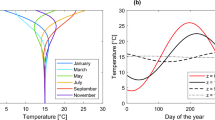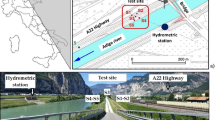Abstract.
Aquifer properties can be evaluated by monitoring artificially stimulated fluid movements between wells, if the fluid is heated. Changes in the temperature profile recorded in observation wells indicate the flow path of the heated fluid, which in effect acts as a tracer. A fluid-flow experiment in the Cretaceous Dakota Formation at the Hodgeman County site, west-central Kansas, demonstrated the advantage of using the distributed optical-fiber temperature sensing method for monitoring transient temperature conditions in this hydrological application. The fluid flow in the aquifer was increased by producing water from a pumping well and injecting heated water in an injection well 13 m (43 ft) distant from the pumping well. The time-temperature series data obtained and compared with results from previous pumping tests point to interwell heterogeneity of the aquifer and to a zone in the sandstone aquifer of high hydraulic conductivity. However, the experiment would have allowed further clarification of aquifer heterogeneity and thermal properties if at least one observation well had been present between the injection and production wells.
Résumé.
Les caractéristiques d'un aquifère peuvent être évaluées en effectuant un suivi des mouvements du fluide stimulés artificiellement entre des puits, si le fluide est chauffé. Les variations de profils de température enregistrés dans les puits d'observation donnent des informations sur les directions d'écoulement du fluide chauffé, qui en fait se comporte comme un traceur. Réalisée dans la formation crétacée de Dakota, sur le site du Comté de Hodgeman (centre-ouest du Kansas), une expérience a démontré l'intérêt d'utiliser la méthode de détection distribuée de température par fibres optiques pour suivre les variations de température dans cette application hydrologique. L'écoulement du fluide dans l'aquifère a été favorisé en extrayant de l'eau par pompage et en injectant de l'eau chaude dans un puits d'injection distant de 13 m du puits de pompage. La chronique de température obtenue et comparée aux résultats d'essais de pompage précédents fait apparaître l'hétérogénéité de l'aquifère entre les puits et l'existence d'une zone de forte conductivité hydraulique dans l'aquifère de grès. Toutefois, l'expérience aurait fourni des éclaircissements supplémentaires sur l'hétérogénéité de l'aquifère et sur ses propriétés thermiques si au moins un puits d'observation avait été placé entre le puits d'injection et le puits de pompage.
Resumen.
Se puede evaluar las propiedades de un acuífero mediante la observación del movimiento de un fluido, calentado artificialmente, entre pozos. Los cambios registrados en el perfil de temperatura de los pozos de observación indican la trayectoria del fluido calentado, el cual actúa como un trazador. Un experimento de este tipo que se realizó en la formación cretácica de Dakota, en el condado de Hodgeman (porción occidental del centro de Kansas, Estados Unidos de América), demostró la ventaja de utilizar el método del sensor de temperatura con fibra óptica distribuída para medir condiciones transitorias de temperatura en esta aplicación hidrológica. El flujo del fluido en el acuífero aumentó con el bombeo de un pozo y la inyección de agua caliente en otro sondeo, que distaba 13 m (43 pies) del primero. Las series de temperatura obtenidas y comparadas con resultados de ensayos de bombeo previos resaltan la heterogeneidad del acuífero entre ambos pozos, así como la existencia de una zona de elevada conductividad hidráulica en el acuífero de la arenisca. Sin embargo, el experimento habría proporcionado más información sobre la heterogeneidad de la formación y sus propiedades termales si se hubiera dispuesto al menos de un punto de observación entre los pozos de inyección y bombeo.
Similar content being viewed by others
Author information
Authors and Affiliations
Additional information
Electronic Publication
Rights and permissions
About this article
Cite this article
Macfarlane, A.P., Förster, A., Merriam, D.F. et al. Monitoring artificially stimulated fluid movement in the Cretaceous Dakota aquifer, western Kansas. Hydrogeology Journal 10, 662–673 (2002). https://doi.org/10.1007/s10040-002-0223-7
Received:
Accepted:
Issue Date:
DOI: https://doi.org/10.1007/s10040-002-0223-7




